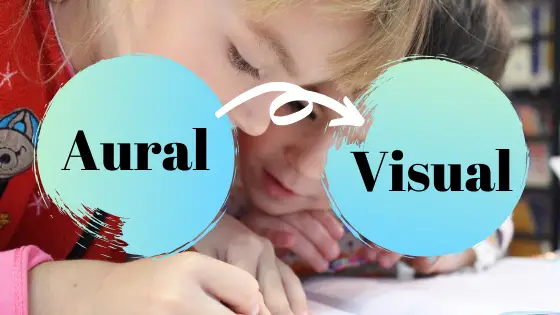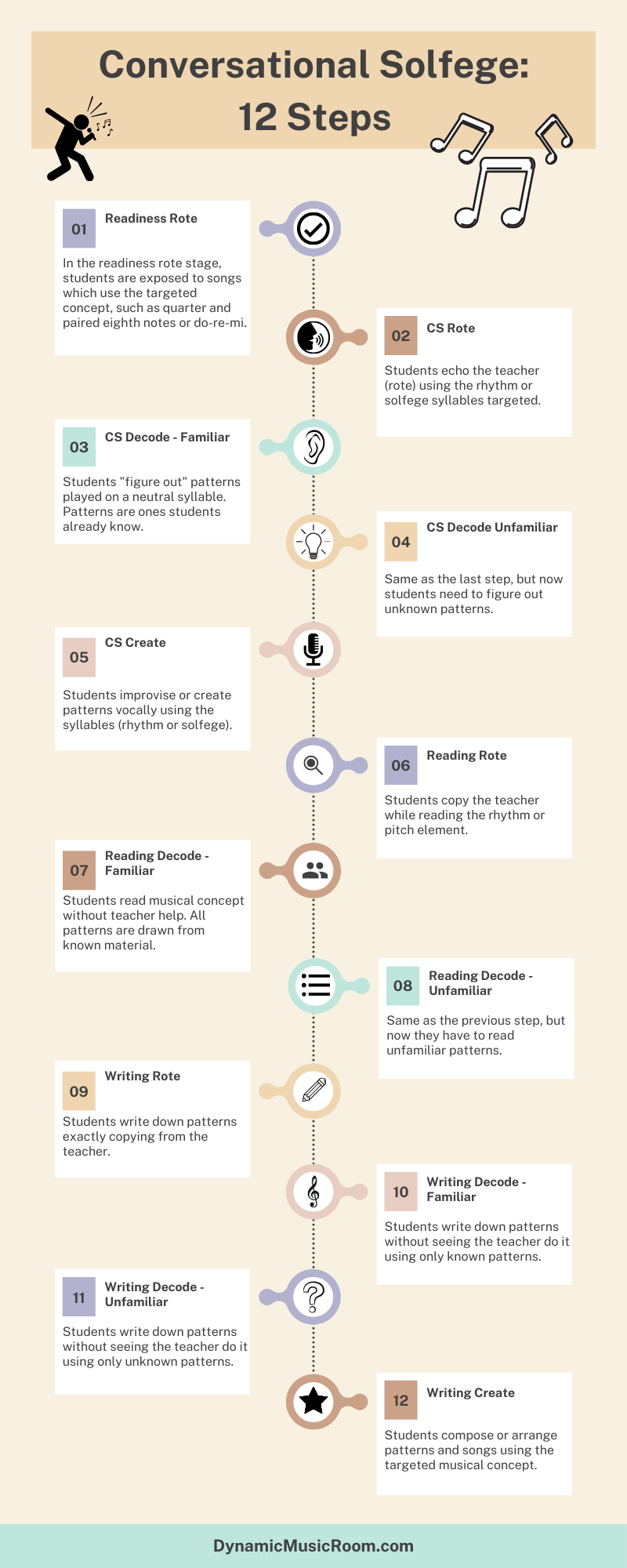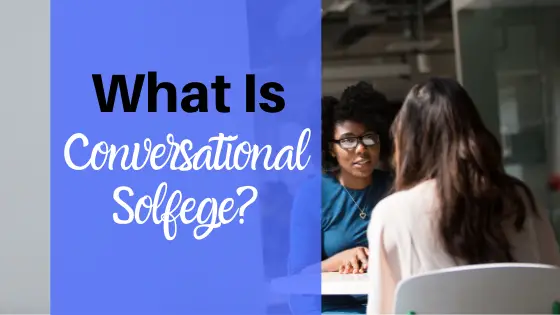Have you recently attended a music education conference where you heard about a relatively new method called “Conversational Solfege”?
Are you interested in attending CS training and buying resources, but you’d like to know more first?
In the age of busy times and low budgets, you need to be picky about what you invest those resources, so I don’t blame you at all. In order to jump in, you need to know:
What is conversational solfege?
Conversational Solfege (CS) is a 1st-8th grade general music method which builds independent musicianship by developing true music literacy using a 12-stage method modeled on how students learn language. This method also focuses on using a variety of authentic folk and classical music.
Read on for more details about the program and its tools.
Note: This overview is meant to be just that, an overview.
It doesn’t replace actual workshops and resources from CS experts.

Tired of searching and searching for songs that work?
I’m saving you headaches and time in finding good activities in this detailed eBook of 30 songs, dances, and activities for elementary music. Get back to making music right now!
Table of Contents
12 Stages To True Music Literacy
Conversational Solfege (CS) is one of the main methods for teaching music education and has gained quite a following in the past 15 years.
As the natural extension to his First Steps In Music program for pre-literacy music classes, Dr. Feierabend created this program to build true music literacy.
True music literacy develops the ability to hear what is seen and see what is heard.
Dr. John Feierabend
To learn more about the 12 Stages, you’ll need to go to a training or buy resources, but here is a brief overview.
Note: More information on this is available through this GIA PDF.
#1 Readiness Rote
In the readiness rote stage, students are exposed to songs which use the targeted concept, such as quarter and paired eighth notes or do-re-mi.
The teacher will also sing patterns using the concept and the students echo on a neutral syllable.
#2 CS Rote
During the conversational solfege rote stage, students practice through a variety of activities performing the targeted concept using rhythm syllables or solfege.
Interestingly, CS doesn’t use solfege hand signs.
Research has shown mixed results on the effectiveness of hand signs, so CS opts out of using them.
Note: CS uses Froseth-inspired rhythm syllables.
#3 CS Decode – Familiar
Decoding refers to aurally “figuring out” the concept or rhythm.
In the CS stage, teachers use a variety of activities to have students hear a pattern or song, figure out the syllables, and perform it back with those syllables.
In this stage, the patterns and songs used are ones the students have been using since through stages #1 and #2.
#4 CS Decode – Unfamiliar
To force students into applying their developing knowledge in new ways, stage #4 repeats similar decoding activities using the concept but with new/unfamiliar patterns and songs.
#5 CS Create
During conversational solfege create stage, students are asked to improvise or create patterns using the concept and syllables you’re targeting.
As with all stages, the CS resources offer detailed activities and games for use with each one.

#6 Reading Rote
Now students are presented with the notation for the targeted concept.
During reading rote, the teacher leads students in call and response reading of the new concept.
#7 Reading Decode – Familiar
For reading, decode refers to students reading the notation without teacher intervention.
Students are guided through fun, engaging activities that build reading skills.
As with the CS stages, first students only read patterns and songs they’ve seen thus far.
#8 Reading Decode – Unfamiliar
For this reading decode stage, students do similar activities as the last stage but now with patterns and songs they haven’t seen before.
#9 Writing Rote
During the writing rote stage, students are asked to copy writing down the notation for the targeted concept matching the teacher.
#10 Writing Decode – Familiar
With writing decode, students are asked to put together all the musical skills they’ve built thus far.
Students hear a pattern they know, figure it out in syllables, and write it down with notation.
The CS resources offer multiple activities for doing this.
#11 Writing Decode – Unfamiliar
This stage is the same as the last but now with patterns they haven’t written before.
#12 Writing Create
With writing create, students reach the ultimate stage of a targeted concept’s literacy.
The students create through composition and writing songs and patterns using the concept.
At the end, a student achieves true music literacy of a concept.
They can:
- Recognize
- Hear internally
- Perform
- Read
- Write
- Compose
- Improvise

Tools Of Conversational Solfege
Conversational Solfege has many iconic tools and teaching techniques.
It should be noted that CS is expected to be used after and in conjunction with the ideas of Dr. Feierabend’s First Steps in Music.
Teaching tools include:
- Froseth-inspired rhythm syllables
- Solfege
- Movable do
- Hand staff
- 12 stages of CS
- Authentic folk songs
- Classical music
- Folk dance
- Segmented, fast-paced, engaging lessons
- Expressive movement development
- Specific concept patterns
- Arioso (singing speak)
- Tuneful, beatful, artful
Conversational Solfege Resources
Most of the Conversational Resources out there are created by Dr. John Feierabend and hosted on GIA Publications.
However, it may be worth it to look on Amazon as well.
Sometimes you can find them cheaper!
Of all the resources, I’ve found the CS Teacher Manuals and the CS Explained DVD set to be the most helpful.
You can also buy the pattern flashcards and a student reading book.
This could help you save time from creating those resources yourself.
Conversational Solfege Compared With Kodaly
A lot of people will notice some similarities between Conversational Solfege and Kodaly.
Dr. Ferieabend was part of the original group of American music teachers who learned from Zoltan Kodaly when he came to Interlochen, MI.
As such, many of the Kodaly tenets may have inspired him in his program.
But there are some notable differences from the other method.
Modified Sequence – Standard Kodaly concept sequence starts with quarter-quarter rest for rhythm, but CS starts with quarter-eighth OR dotted quarter-quarter eighth in triple.
Also, standard Kodaly sequence starts on sol-mi for pitches, but CS starts with do-re-mi.
Separation of Visual and Aural – In the Kodaly prepare-present-practice concept sequence, students rotate through the aural and visual aspects of a concept.
With CS, the teacher separates the aural skills first (stages #1-5) and then teaches the visual notation skills second (stages #6-12).
Removal of Questioning – One big part of the prepare stage in Kodaly are the questions you ask about the concepts. For example, when discussing sol-do, you may ask:
“Is this sound higher or lower than the other? How much lower?”
CS leaves this questioning out in favor of repetition and different activities.
Lack of Hand Signs – One of the most easily recognized tools of Kodaly is the Curwen hand signs.
With CS, they opt out of using these, believing the hand signs are extra work that serves no proven benefit. Dr. Feierabend has advocated for use of the hand staff (pointing to finger like the 5-line staff).
No iconic notation – Another icon (pun-intended) is the presence of pictures used to represent concepts in the preparation stage of a concept.
For example, pictures of raindrops may be grouped together to represent quarter notes and eighth notes in the song, “Rain, rain go away.”
CS doesn’t use this iconic stage.
It’s believed once the concept is solidified aurally, there is no need for this stage and notation works just fine.
Interested in Kodaly? Learn about what Kodaly training is.
Personal Story
Dr. Feierabend and his Conversational Solfege actually made a huge impact on my career.
In my second year working towards my undergraduate degree in Music Education at Central Michigan University, I felt lost.
I loved music, but I was unsure if I wanted to continue down the path of music teaching or switch to a general education degree.
In my Intro to Music Ed. class, we went to observe different teachers in the area.
When I saw what this one woman, Joan Long, did with her young music students, I was floored.
This looked like fun, the students were actually learning things, AND I could easily see how the students were developing a love for music and music literacy.
She could tell I was interested in elementary music and invited me along to a workshop.
During that workshop, I was converted to general music, dove in wholeheartedly, and never looked back.
This workshop was an introduction to First Steps In Music and Conversational Solfege by the creator himself, Dr. John Feierabend.
Is Conversational Solfege A Curriculum?
Conversational Solfege is not a full curriculum, but it does provide enough resources to easily build one based on where your students are at. A curriculum provides lessons and activities for the entire year or program, but C.S. stops short of this due to the wide range of music offerings at different schools.
When some schools only have music once per week, and some have it twice, it’s tough to build a curriculum matching everyone.
Instead, Conversational Solfege sets you up with plans and tools for developing your own curriculum based on your specific situation.
Another example of why most music methods don’t include a detailed curriculum is based on grade-level offerings.
Based on a recent elementary music statistics research study I did, Fifth grade and Kindergarten are around 10% less likely to get music.
If your school doesn’t have Kindergarten, a curriculum that starts at Kindergarten won’t work.
And if you don’t have a fifth grade, they won’t get as far as you may want them to.
This is where a program like this gives you the adaptability to reach the students where they are at.
How Do You Use Conversational Solfege?
Use Conversational Solfege as a tool to do the following:
- Find the students where they’re at in terms of skills
- Expose them to quality music activities
- Move them along an understanding and facility with music concepts.
Conversational Solfege provides, at the broad level, a general guide for teachers to follow as to what concepts to teach when.
On a detailed level, it’ll give you songs and teaching techniques to follow when helping students discover these ideas in music reading and performance.
Who Invented Conversational Solfege?
Dr. John Feierabend developed conversational Solfege as his response to how he thought a Kodaly sequence and tools should be applied to American music education. It alters and streamlines the Prepare-Present-Practice cycle and uses different rhythm syllables.
Can I Receive Conversational Solfege Training?
Conversational Solfege training is offered in levels-style classes held for two weeks in the summer. Visit Feierabendmusic.org for more information on where the trainings are held.
Often, training is offered at a workshop rate and a university credit rate.
The university credit option costs more and requires an additional paper or reflection.

Save time with these 60 FREE Music Resources to use in your room right away!
Stop searching the whole internet to find good activities. I’ll help you cut to the chase with my favorite 60 FREE resources.
Conclusion
Now you know a little about what conversational solfege is.
This 1st through 8th grade is detailed, authentic, and rooted in best teaching practices.
If you’re interested, go attend a CS workshop or training.
Having gone to several workshops, I can highly recommend it!


